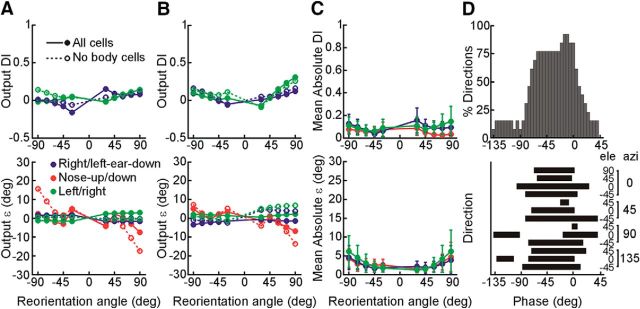Figure 9.
Decoding body-centered motion in 3D from the recorded rFN population. A, B, DI (top) and ε (bottom) as a function of head reorientation angle toward nose-up/down (red), right/left-ear-down (blue), and left/right (green) for an output unit with a PD along the y axis (90° azimuth, 0° elevation). The output unit was decoded from a weighted linear sum of either (A) simplified cosine-tuned representations of the preferred spatial tuning properties of our recorded rFN cells (i.e., STC properties/phases were not taken into account) or (B) tuning functions that incorporated their full spatiotemporal tuning characteristics. The decoded body-centered unit in B has a phase lag of 15° relative to acceleration in its PD. Filled symbols and solid lines represent decoding performance using all rFN cells recorded across 3 head orientations (N = 25) as inputs. Open symbols and dashed lines represent decoding performance using all cells, with the exception of those classified as body-centered (N = 21). DIs are shown only for ear-down and left/right head reorientation because the DI is undefined for nose-up/down reorientation about an axis aligned with the output unit's PD (i.e., no tuning shift is predicted for nose-up/down reorientation for this unit and thus any observed shift is described by ε). C, Average decoding performance (mean absolute DI and ε) across 13 motion directions (spaced at 45° intervals in azimuth and elevation; Fig. 1C) for each head orientation and plane using the full STC tuning properties of all rFN cells recorded across 3 head orientations. Means were computed using the DI and ε values for each direction associated with the output phase at which the best decoding performance (lowest regression mean-squared error) was obtained. Error bars indicate standard deviation (SD) in DI and ε values across directions for reorientations in each plane. D, Distribution of phases relative to translational acceleration that could be successfully decoded across directions. The percentage of motion directions for which body-centered representations having each phase could be decoded (top) and the range of phases decoded for each motion direction (bottom) are illustrated for all decoded representations meeting the following criteria across head angles up to ±90° for reorientation in each plane: (1) average absolute DI < 0.15; (2) average absolute ε < 15% the angular change in head orientation angle; (3) average gain changes relative to upright of <15%; and (4) average phase change relative to upright <10°.

